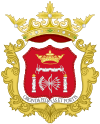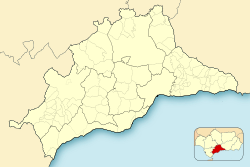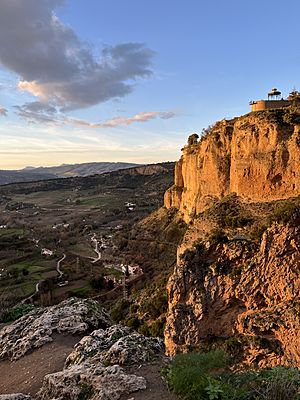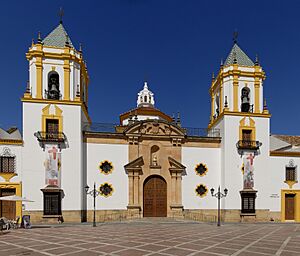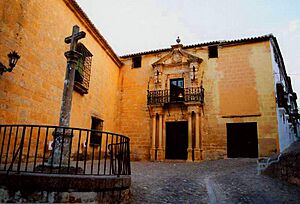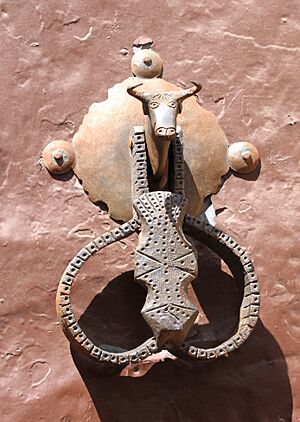Ronda facts for kids
Quick facts for kids
Ronda
|
|||
|---|---|---|---|
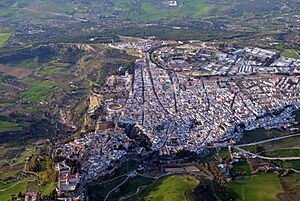
Aerial view of Ronda, with the Puente Nuevo
|
|||
|
|||
| Country | Spain | ||
| Autonomous community | Andalusia | ||
| Province | Málaga | ||
| Area | |||
| • Total | 481.31 km2 (185.83 sq mi) | ||
| Elevation | 739 m (2,425 ft) | ||
| Population
(2018)
|
|||
| • Total | 33,978 | ||
| • Density | 70.5948/km2 (182.840/sq mi) | ||
| Demonym(s) | Rondeños | ||
| Time zone | UTC+1 (CET) | ||
| • Summer (DST) | UTC+2 (CEST) | ||
| Postal code |
29400
|
||
| Dialing code | 95287, 95219 | ||
Ronda is a beautiful town in Spain, located in the province of Málaga within the region of Andalusia. It is famous for its amazing location on top of cliffs, with a deep canyon called El Tajo running through it. The Guadalevín River flows at the bottom of this canyon, dividing the town into two parts. About 35,000 people live in Ronda, and it's part of the Sierra de las Nieves National Park.
Contents
Ronda's Past: A Journey Through Time
Ronda has a very long history! People have lived here since the Neolithic period, which was thousands of years ago. You can still see ancient rock art in the Cueva de la Pileta cave nearby.
Early Settlements and Roman Times
Ancient writers like Pliny the Elder mentioned places called Arunda and Acinipo. These are believed to be early names for Ronda.
From Visigoths to Islamic Rule
In the 5th century AD, a group called the Suebi took over Ronda. Then, the Eastern Roman Empire (also known as the Byzantine Empire) took control. Later, the Visigoths ruled the city. In 713, Ronda became part of the Islamic empire and was called Hisn al-Rundah, meaning "Castle of Rundah." It became an important capital in the region.
- Abbas ibn Firnas: A famous inventor and scientist named Abbas ibn Firnas was born in Ronda around 810 AD. He was known for many things, including engineering and poetry.
The Taifa Kingdom of Ronda
After the big Islamic empire broke apart, Ronda became the capital of its own small kingdom, called the taifa of Ronda. During this time, many beautiful Islamic buildings were constructed. In 1065, a larger kingdom, the taifa of Seville, conquered Ronda.
Ronda Under Christian Rule
In 1485, Christian forces led by Rodrigo Ponce de León, Duke of Cádiz took Ronda. Many of the old Islamic buildings were changed or new Christian ones were built. The famous Plaza de Toros de Ronda, a bullfighting ring, was founded in 1572.
Changes for Muslims in Spain
After 1492, when the last Muslim kingdom in Spain fell, the Spanish government made a rule: all Muslims had to leave Spain or become Christian. Many chose to convert openly but secretly kept their faith. These people were called Moriscos. They faced many restrictions, including rules about what they could wear and heavy taxes. This led to some rebellions, including one in Ronda. Eventually, many Moriscos were forced to leave Ronda.
Ronda in Modern Times
In the early 1800s, the Napoleonic Wars caused a lot of hardship in Ronda. The town's population dropped significantly. The area became known for guerrilla warfare and bandits, which inspired famous writers. In 1918, Ronda was important for the Andalusia region, as its flag, coat of arms, and anthem were designed here.
The Romero Family and Bullfighting
The Romero family from Ronda played a huge role in developing modern Spanish-style bullfighting. From Francisco in the late 1600s to his grandson Pedro Romero, this family introduced new techniques, like using the cape. Pedro Romero especially helped turn bullfighting into a respected art form.
Ronda and the Spanish Civil War
Ronda was deeply affected by the Spanish Civil War in the 1930s. This led many people to leave the town. The famous writer Ernest Hemingway wrote about events in a fictional village in his book For Whom the Bell Tolls, which some believe was inspired by real events in Ronda.
Ronda's Geography: Where Cliffs Meet Rivers
Ronda is located in a mountainous area, about 750 meters (2,460 feet) above sea level. The land inside the city is gentle, with areas for farming and pastures. The Guadalevín River flows right through the city, creating the dramatic El Tajo canyon, which is over 100 meters (330 feet) deep. The city sits on the edge of this impressive canyon. A special type of tree, the Spanish fir, grows only in the mountains around Ronda.
Main Sights: What to See in Ronda
Ronda is full of amazing places to visit!
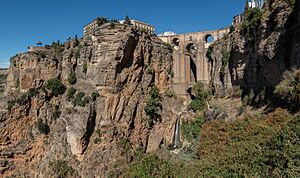
The Famous Bridges of Ronda
Three incredible bridges cross the deep Tajo canyon, connecting the two parts of the city:
- Puente Romano ("Roman Bridge"): This bridge has Roman foundations but was rebuilt during the Arabic period, so it's also called the "Arabic Bridge."
- Puente Viejo ("Old Bridge"): Also known as the "St. Michael's Bridge."
- Puente Nuevo ("New Bridge"): This bridge is the most famous. Even though it's called "New," it took a long time to build, from 1751 to 1793! It's the tallest of the bridges, standing 120 meters (390 feet) above the canyon floor. The old town hall, right next to the Puente Nuevo, offers stunning views of the Tajo canyon.
Plaza de Toros de Ronda: The Oldest Bullring
The Plaza de Toros de Ronda is the oldest bullfighting ring in Spain. It was built in 1784 in a style called Neoclassicism. An architect named José Martin de Aldehuela, who also designed the Puente Nuevo, created it. Once a year, a special bullfight called the Corrida Goyesca takes place here.
Baños Arabe: Ancient Arabic Baths
Below the city, near the Arabic Bridge, you can find the partially preserved Baños Arabe ("Arabic baths"). These baths date back to the 13th and 14th centuries. They are no longer used for bathing but are open for visitors to explore. They are considered some of the best-preserved Arabic baths.
Plaza del Socorro: A Modern Center
The Plaza del Socorro is a modern central square in Ronda. In 1918, Blas Infante showed the Andalusian flag and coat of arms here for the first time. The church of Socorro was built in 1956. The Casino and Artists' Society building is also located on this square.
Palace of the Marqués de Salvatierra
The Palace of the Marqués de Salvatierra sometimes opens as a small museum. This palace was built in the 18th century, but it was a renovation of an older 16th-century building. It was given to the Salvatierra family by the Catholic Monarchs after the Reconquista.
Casa del Rey Moro: The House of the Moorish King
Despite its name, the Casa del Rey Moro ("House of the Moorish King") was never actually home to a Moorish king. It was built in the 18th century. Its beautiful gardens were designed much later, in 1912. However, the house does have an important part from Ronda's Moorish past: the Water Mine. This is a set of steps carved into the cliff leading down to the river.
Serranía de Ronda: White Villages
The area around Ronda, called Serranía de Ronda, is full of charming pueblos blancos (white villages) that you can visit by car. Ronda itself offers amazing views of these surrounding mountains.
Cultural Influence: Ronda in Art and Stories
Ronda has inspired many famous artists and writers from around the world.
Writers and Filmmakers in Ronda
- Ernest Hemingway and Orson Welles: These famous American artists spent many summers in Ronda. They both wrote about Ronda's beauty and its bullfighting traditions, which helped make the town more popular. Hemingway's novel For Whom the Bell Tolls has a scene that some believe was inspired by events in Ronda during the Spanish Civil War. Orson Welles was also inspired by his visits to Spain and Ronda. After he passed away in 1985, his ashes were buried on the property of his friend, a bullfighter named Antonio Ordóñez.
- Rainer Maria Rilke: A well-known German poet, Rilke spent a lot of time in Ronda in the early 20th century. He loved the city and wrote, "I have sought everywhere the city of my dreams, and I have finally found it in Ronda."
- George Eliot: The English writer George Eliot wrote a book called Daniel Deronda ("Daniel of Ronda"). Some people think her ancestors might have lived in Ronda before the expulsion of the Jews from Spain in 1492.
Ronda in Fashion and Film
- Giorgio Armani: In 2009, the famous Italian fashion designer Giorgio Armani created a special bullfighting costume for the bullfighter Cayetano Rivera Ordóñez for the Corrida Goyesca in Ronda.
- Ferdinand: The animated movie Ferdinand (2017) used Ronda as the setting for its flower market scene.
Transport: Getting to Ronda
Ronda is easy to reach! You can get there by highways (Autovía A-374) or by train from cities like Algeciras and Córdoba. There's even a direct train from Madrid to Ronda twice a day.
The Ronda Railway
The railway line between Ronda and Algeciras was built between 1890 and 1892. It was originally created to help British military officers escape the summer heat in Gibraltar. The Ronda train station opened in 1892.
International Connections: Sister Cities
Ronda has special connections with other cities around the world, called "twin towns" or "sister cities." These connections help promote cultural exchange and friendship.
 Cuenca, Spain
Cuenca, Spain Chefchaouen, Morocco
Chefchaouen, Morocco Castiglion Fiorentino, Italy
Castiglion Fiorentino, Italy Ontinyent, Spain
Ontinyent, Spain Ceuta, Spain
Ceuta, Spain
|
See also
 In Spanish: Ronda para niños
In Spanish: Ronda para niños



